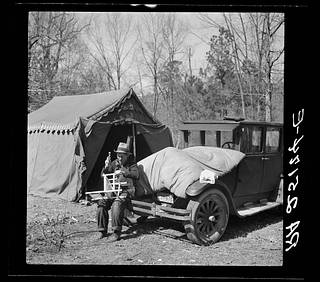
Similar
Making chairs to sell to tourists in a migrant camp on highway near Birmingham, Alabama
Summary
Title and other information from caption card.
Transfer; United States. Office of War Information. Overseas Picture Division. Washington Division; 1944.
More information about the FSA/OWI Collection is available at http://hdl.loc.gov/loc.pnp/pp.fsaowi
Temp. note: usf34batch3
Film copy on SIS roll 28, frame 2534.
The automobile was first invented and perfected in Germany and France in the late 1890s. Americans quickly came to dominate the automotive industry after WWI. Throughout this initial era, the development of automotive technology was rapid. Hundreds of small manufacturers competing to gain the world's attention. Key developments included the electric ignition system, independent suspension, and four-wheel brakes. Transmissions and throttle controls were widely adopted and safety glass also made its debut. Henry Ford perfected mass-production techniques, and Ford, General Motors, and Chrysler emerged as the “Big Three” auto companies by the 1920s. Car manufacturers received enormous orders from the military during World War II, and afterward automobile production in the United States, Europe, and Japan soared.
Arthur Rothstein arrived in the Dust Bowl Boise City, Oklahoma in April of 1936 hired by his former professor Roy Stryker, at the Resettlement Administration. It was a New Deal agency that relocated struggling families to communities built by the federal government. He shot the most famous photograph of his career at the homestead of Art Coble in rural Cimarron County. "I was about to get into my car when I turned to wave to... And I looked and saw this man bending into the wind, with one of the boys in front of him and another one behind him, and great swirls of sand all around, which made the sky and the earth become one. And I said, 'What a picture this is!' and I just picked up my camera and went 'click.' One photograph, one shot, one negative." The image Rothstein captured at the Coble farm was soon widely reprinted across the country, becoming the iconic picture of the Dust Bowl and one of the most widely reproduced photographs of the 20th century. Rothstein is remembered as one of America's most influential photojournalists.
Tags
Date
Location
Source
Copyright info

![Early automobiles - [Family car camping] Early automobiles - [Family car camping]](https://cache.getarchive.net/Prod/thumb/cdn4/L3Bob3RvLzE5MTUvMDEvMDEvZmFtaWx5LWNhci1jYW1waW5nLTMtNjQwLmpwZw%3D%3D/40/29/jpg)
























